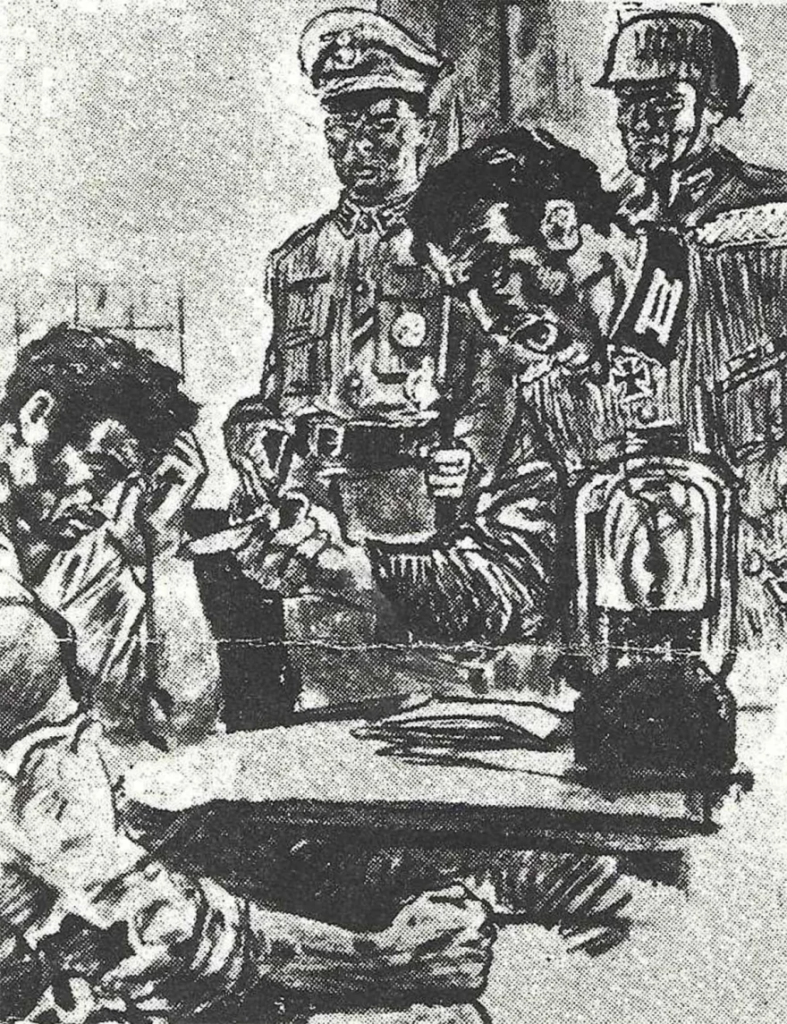During the Occupation, many Greeks actively participated in the resistance against the occupiers, causing significant headaches for the Germans and Italians. Some became widely known, despite the disproportionate publicity compared to their actions. On the other hand, there were others whose contributions were crucial and often put their lives at risk, yet they received relatively little recognition in the immediate post-war years. Eventually, as they did not seek to “cash in” on their wartime efforts, they faded into obscurity.

For most historians, the top saboteur of the Occupation was the Greek-Polish Georgios Ivanoff (1911-1943), to whom we dedicated an article on January 21, 2023. Recently, when we read about the Greek “ghost saboteur” Georgios Varnakiotis and his incredible acts of bravery right before the Germans, we sought more information about him. We found it in a rare book by Andreas M. Argyris titled The Ghost Saboteur of World War II, published in 1984. In this book, Varnakiotis, then 67 years old, shared his story before passing away 30 years later, in 2014, at the age of 97. Until now, there hasn’t been a comprehensive biography of Varnakiotis available online, and we hope that this tribute will help him gain wider recognition.

Who Was Georgios Varnakiotis?
Georgios Varnakiotis was born in 1917 in Spartochori, a beautiful village on the island of Meganisi, near Lefkada. He was a descendant of the 1821 hero, chieftain Georgios Varnakiotis. His profession was sailor, specifically as a boatswain. When the Greco-Italian War broke out, Varnakiotis was in his village. Along with other villagers, he was called to report to Piraeus, where he was placed on a requisitioned ship named “Daphne,” transporting ammunition from Patras to various locations. Before the front collapsed, the “Daphne” was bombed by Italian planes and was repaired in Corfu. During Easter 1941, the ship transported supplies for the Army in Itea. After the German invasion of Greece, the “Daphne” was ordered to transport Greek troops from Patras to Pylos, where they would be picked up by British ships to be sent to the Middle East. After one journey, the “Daphne” anchored in Trizonia, Fokida. The Germans ordered the ship’s captain to go to Patras, but Varnakiotis took the initiative to force the captain to head to Meganisi instead, which was achieved after several adventures.

In Spartochori, he was introduced to the National Resistance by retired Colonel Anastasios Politis and two other retired officers, Spiridon Argyris and Georgios Argyris. The resistance fighters in the village had gathered several weapons, which they had hidden in a cave for future use.
However, their efforts were betrayed to the Italians, who arrested several young men from Spartochori. Varnakiotis, along with Nikolaos Argyris, Mitsos Maroulis, and Fotis Politis, managed to reach the shores of Aetolia-Acarnania and eventually hid in a house in the now-deserted village of Dragamesto. There, they were joined by three other fellow sailors who were also part of the Resistance: Captain Dimitris Palmos Nikos Kontis, and Stamatios Kareklas. However, they were betrayed by a gamekeeper to the Italians. Consequently, 1,500 (!) Italians surrounded the two houses where the seven Spartochorians had taken refuge. The only one who managed to escape was Varnakiotis, who cleverly dressed in women’s clothing! From Dragamesto, Varnakiotis went to the village of Chryso-visa, where his cousin was married, and from there to the village of Podovolitsa. The Italians, furious that the others had been captured while he escaped in women’s clothing, intensified their efforts to capture him and issued a “criminal bulletin” sent to all German and Italian occupation authorities, describing Varnakiotis as “extremely dangerous.”
However, the brave Meganisiot reached Messolonghi under the alias Georgios Karaiskos on a cart of straw and from there took a ship to Patras. In the Peloponnese city, he met, among others, the owner of the “Daphne,” Livitsanos, who owed him a great favor for saving his ship. Livitsanos gave him money and helped him flee to Piraeus.

From Piraeus, Varnakiotis went to Athens, where he was hosted for several days by Dr. Athanasios Katapodis. In the capital, he met his fellow townsman and relative, Thomas Sykioitis, who was part of the crew of a tugboat requisitioned by the Germans at the Salamis naval base. Varnakiotis recounted his adventures to Sykioitis, who suggested he work as a captain on the tugboats.
“I can’t work for those dogs, even if I’m starving,” Varnakiotis said.
However, unable to find work, he approached Sykioitis again and asked him to intercede for the job he had suggested. After a few days, Varnakiotis started working as a captain on a tugboat at the naval base.
Joining the “Apollo” Organization – His Training in Time Bombs – His First Sabotage
Sykioitis was involved in a secret patriotic organization, “E.O.P.D. APOLLO,” which had a liaison named Vasilis Smbosdas. No member of the APOLLO organization knew the others, or the leader. Members had to be tested patriots, brave, and not at all talkative. Sykioitis recognized Varnakiotis’s qualifications and wanted to recruit him for “APOLLO.” Varnakiotis worked for some time as a captain on the tugboats at the naval base. He worked diligently and industriously to gain the Germans’ trust.
One night, an incident occurred that earned Varnakiotis the absolute trust of the Nazis. He transported four German naval officers of various specialties from Perama to the naval base. All four were drunk. One of them fell overboard and was at risk of drowning. Varnakiotis jumped into the water, risking his life to rescue the German officer and performed artificial respiration to revive him, as the German had lost consciousness. Ensuring none of the other three drunken officers fell overboard, Varnakiotis safely transported them to the naval base. From that point on, the Germans had unlimited trust in him, which would help him later. Sykioitis had spoken about Varnakiotis, his national actions, and his bravery to Vasilis Smbosdas, who worked as the head of the signaling office at the naval base, relaying the Germans’ movements to the Allies. Smbosdas recruited Varnakiotis into the “Apollo” organization, trained him in handling and placing time bombs, and managed to enlist him on the ship M.21, a special auxiliary tugboat (referred to as “petroletta” later by Andreas M. Argyris) as captain, alongside a mechanic named Dimitris (Mitsos).
Due to his good conduct and the trust the Germans had in Varnakiotis, he was the only one allowed to go to the small island of Leros, near Salamis. In the tunnels, the Germans had stored vast amounts of ammunition, effectively making it their powder keg. Michael Skandalidis writes about Leros in Saronikos, which is not to be confused with Leros in the Dodecanese, noting that it was likely joined to Salamis in ancient times, as Strabo (X 395) refers to the nearby Farmakousas and not Leros, which is much larger. No other author mentions Leros, either. On European maps, that part of Salamis that was cut off was marked as I. Nero. This name appears to have been given to the pine-covered islet that was separated. This view is supported by the later name Arapis given to the cape of Salamis, as “nero” means black in Italian. Thus, Leros < Italian “nero.” The island is also referred to as Learo by some travelers.

The Explosions of the Tugboats “Titan” and “Heracles”
Varnakiotis’s first act of sabotage was the explosion of the tugboats “Titan” and “Heracles,” which had capacities of 500 and 200 tons, respectively. They were anchored near the partially sunken battleship “Limnos.” On the night of September 4, 1943, he approached the two tugboats. The area where they were moored was under German control. Varnakiotis acted swiftly.
He dove into the water and placed explosives on the hull of the “Titan.” This action took him only two minutes (!) as he exploited the brief time required for the change of guards! At 2 AM, a tremendous noise from successive explosions and bright flashes awakened everyone. The “Titan” sank almost immediately. The tugboat “Heracles,” tied next to the “Titan,” collided violently with the sunken battleship “Kilkis” at the dock as the “Titan” sank. The Germans ordered Varnakiotis to tow the “Heracles,” but
Ask me anything
Explore related questions





